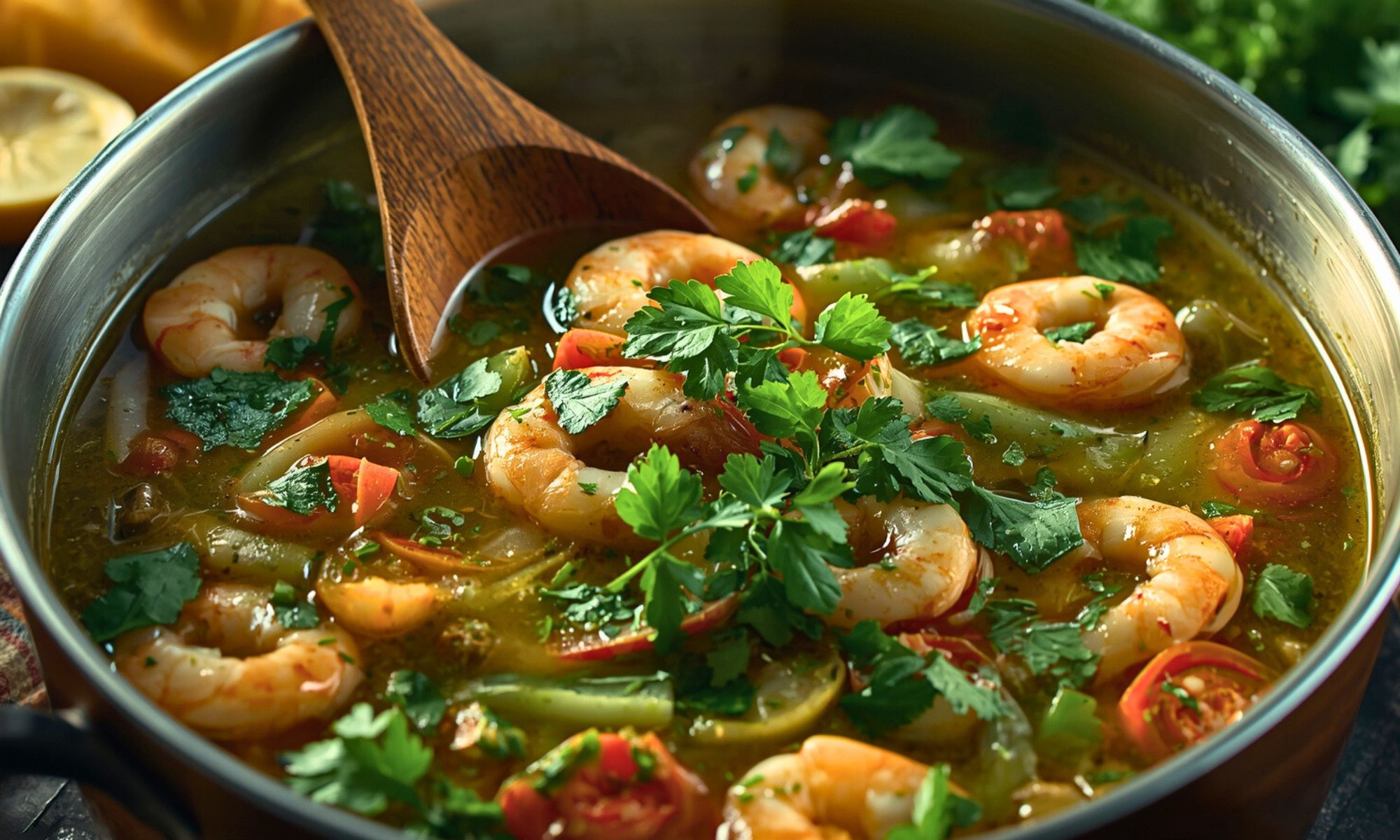The kitchen light flickered, my phone buzzed nonstop, and dinner felt impossible. Takeout was tempting, but the craving for something warm and real pushed me toward Peruvian Seafood Stew with Cilantro Broth, a bowl that promised comfort and flavor strong enough to reset the whole evening mood.
I wasn’t exactly prepared. The freezer gave me shrimp, the fridge held a few clams, and a nearly forgotten bunch of cilantro was clinging to life. Not a planned recipe, just me trusting that with garlic, onions, and a little heat, something good could rise out of kitchen chaos.
And it did. Butter hissed, garlic filled the air, cilantro painted the broth bright and bold. The seafood tumbled in, shells clattering as steam lifted from the pot. Minutes later, I had stew that tasted briny, fresh, and soulful, comforting without heaviness, vibrant without fuss.
What Makes This Peruvian Seafood Stew with Cilantro Broth Special

Here’s what most people don’t know about Peruvian cooking. It’s not just about throwing cilantro on top of things. The technique we’re using today actually infuses the entire cilantro plant, stems, leaves, even those tender roots if you can get them, into a broth that’s been perfected over centuries.
The result? A stew that tastes like the ocean decided to vacation in an herb garden.
This particular Peruvian seafood stew with cilantro broth comes from the coastal regions where ceviche was born, but it’s the comfort food cousin that deserves way more attention. While ceviche gets all the Instagram love, this stew is what Peruvian families actually make when they want something that hugs you from the inside out.
Traditional aguadito is typically made with just cilantro and rice, but my version brings in coconut milk for silky richness that mellows the herb’s sometimes aggressive edge. Consider it my love letter to both Peruvian tradition and modern tastes.
Essential Ingredients for Your Peruvian Seafood Stew with Cilantro Broth
Let me walk you through this like we’re shopping together at my favorite market. We’ll grab everything in the order that makes sense when you’re actually cooking, none of that alphabetical madness that leaves you scrambling.
For the Cilantro Base:
- 2 large bunches fresh cilantro, divided (reserve half for blending, half for garnish)
- 4 cups fish stock
- 1 large white onion, diced
- 4 garlic cloves, minced
- 1 jalapeño, seeded and chopped (leave seeds for more heat)
- 2 tablespoons olive oil
The Seafood Stars:
- 1 pound firm white fish (mahi mahi or sea bass), cut into 2 inch chunks
- ½ pound large shrimp, peeled and deveined
- ½ pound mussels, cleaned and debearded (discard any cracked or open ones)
- Optional: ½ pound calamari rings
Supporting Cast:
- 2 medium potatoes, cut into ¾ inch cubes
- 1 cup corn kernels (fresh or frozen)
- 1 can (13.5-14 oz) coconut milk
- Juice of 2 limes
- Salt and white pepper to taste
- 1 teaspoon ground cumin
- 1-2 tablespoons aji amarillo paste (or yellow bell pepper substitute)
Now, about those smart swaps. Can’t find aji amarillo? Don’t stress. Mix some roasted yellow bell pepper with a tiny bit of turmeric and a dash of honey. It won’t be exactly the same, but it’ll give you that sweet heat that makes this dish sing.
Living somewhere that cilantro costs more than gold? You can stretch one bunch by using parsley for half the amount, but know that you’re trading some of that distinctive punch for a milder flavor.
The fish choice matters more than you might think. You want something that won’t fall apart when it hits that simmering broth. Mahi mahi is my go to because it stays firm but still flakes perfectly. Sea bass is the splurge option that’ll make this restaurant quality.
For the mussels, give them a good scrub under cold water and pull off those beard like threads. Tap any open ones, if they don’t close, toss them out. Same goes for any cracked shells.
Building Your Peruvian Seafood Stew with Cilantro Broth Like a Pro
Prep Time: 20 minutes | Cook Time: 30 minutes | Serves: 4-6
This is where the real magic happens, and where most people either nail it or completely miss the mark. The difference between good and extraordinary lies in how you handle that cilantro.
Start by washing your cilantro bunches thoroughly. Separate one bunch for blending with stock later; reserve the other bunch’s prettiest leaves for garnish.
Heat your olive oil in a large, heavy bottomed pot over medium heat. Add your diced onion and cumin, letting them sweat until the onion’s translucent, about 5 minutes. This isn’t about browning; we want that gentle, sweet release of flavor.
Toss in the garlic and jalapeño. Give them just 30 seconds to wake up and start smelling incredible. Any longer and you risk bitter garlic, which will haunt your entire pot.
Take your first bunch of cilantro, stems, leaves, everything, and blend it with 1 cup of the fish stock until smooth. Add this vibrant green puree to your pot along with the remaining stock. Bring to a gentle simmer and cook for 8-10 minutes. Don’t let it boil hard, that’ll turn your beautiful cilantro bitter.
The aroma that rises up? That’s pure Peruvian coastline right there.
Perfecting Your Seafood Timing in This Peruvian Cilantro Stew
While that broth is working its magic, let’s talk about the seafood timing. This is where good cooks separate themselves from great ones.
Different seafood needs different cooking times, and throwing everything in at once is a rookie mistake that results in rubbery shrimp and mushy fish. We’re going to layer this like a conductor building a symphony.
Add your cubed potatoes to the simmering broth first, they need about 10 minutes to start getting tender. Season with white pepper and salt to taste.
Now add your fish chunks and let them poach gently for about 4 minutes. Pour in the coconut milk and stir in the aji amarillo paste, this is my modern twist that adds silky richness to traditional aguadito. Stir gently so you don’t break up those fish pieces. This Peruvian seafood stew with cilantro broth should smell absolutely incredible by now.
Corn kernels and mussels join the party for the next 3 minutes. The mussels will start opening, which is nature’s way of telling you they’re ready.
Finally, add the shrimp and calamari (if you’re using it) for the last 2 minutes. Shrimp cook lightning fast, and overcooked shrimp is a crime against good eating.
Remove from heat and stir in that fresh lime juice. This brightens everything and adds that final layer of complexity that makes this dish sing.
adds that final layer of complexity that makes this dish sing.
The Science Behind This Coastal Magic

What’s actually happening in that pot is pretty fascinating stuff. When you blend cilantro with liquid, you’re extracting different flavor compounds than you would by just wilting the leaves. The blending breaks down cell walls, releasing more of those essential oils that give cilantro its distinctive punch.
The coconut milk isn’t just there for richness. It’s acting as a flavor bridge, mellowing out the cilantro’s sometimes aggressive edge while adding body to the broth. Plus, it carries those fat soluble flavor compounds around your palate in ways that water based broths simply can’t match.
That gentle poaching technique we’re using? It keeps the proteins tender while allowing them to contribute their own flavors to the broth. High heat would toughen proteins and make everything chewy rather than letting flavors mingle beautifully.
The lime juice at the end isn’t just seasoning, it’s brightening and balancing all those rich, earthy flavors. It’s the equivalent of adjusting the treble on your stereo to make everything crystal clear.
Presentation That’ll Make Them Swoon
This Peruvian seafood stew with cilantro broth is naturally gorgeous, but a few simple touches will make it Instagram worthy. Ladle it into deep bowls, making sure each person gets a good variety of seafood.
Garnish with those reserved fresh cilantro leaves, the pretty, intact ones you saved from the beginning. A lime wedge on the side isn’t just traditional; it lets people adjust the brightness to their taste.
If you want to get fancy, drizzle a tiny bit of good olive oil on top just before serving. It catches the light and adds that final layer of richness.
Serve this with crusty bread for sopping up that incredible broth, or go traditional with some boiled yuca on the side. A simple salad of sliced avocado with red onion and lime dressing makes this feel like a complete Peruvian feast.
Wine pairing? Go with something that won’t compete with all those bright flavors. A crisp Sauvignon Blanc or a light Pinot Grigio works beautifully. If you prefer red, choose something light like a Pinot Noir served slightly chilled.
Mastering the Perfect Peruvian Seafood Stew with Cilantro Broth
Once you’ve nailed the basic technique, this stew becomes your canvas for creativity. Want more heat? Add another jalapeño or some fresh ají rocoto if you can find it. Craving more depth? A splash of pisco (Peru’s national spirit) added with the lime juice creates layers of complexity.
Some families add a beaten egg in the last minute, stirring it in to create silky ribbons throughout the broth. Others throw in some quinoa for extra heartiness, very Peruvian and totally delicious.
The beauty of this Peruvian seafood stew with cilantro broth lies in its flexibility. It’s a technique more than a rigid recipe, which means it’ll evolve with your tastes and what’s available in your market.
Storage and Reheating Your Cilantro Broth Creation
Here’s something crucial that most recipes don’t tell you. The broth keeps beautifully for 2 days in the fridge and actually improves with time as those flavors deepen and marry.
But, and this is important, never store the seafood in the broth if you’re planning leftovers. Cook the seafood fresh each time you reheat. Trust me on this one. Reheated seafood turns into rubber balls that’ll make you swear off stew forever.
To reheat, bring your broth base back to a simmer, then add fresh seafood following the same timing sequence. Takes just 10 minutes and tastes like you just made it from scratch.
Troubleshooting Your Peruvian Seafood Stew Adventures
Let’s talk about what can go wrong and how to fix it. Because even with the best instructions, sometimes kitchens have minds of their own.
If your broth tastes too mild, you probably didn’t blend enough cilantro into the stock. Next time, don’t be shy, that herb is the star of this show. Add more cilantro puree gradually until it reaches that vibrant, herbaceous flavor you’re after.
Bitter broth usually means the cilantro got overcooked or boiled too hard. Keep that simmer gentle and never let it come to a rolling boil once you’ve added the cilantro mixture.
Tough seafood? You cooked it too long or at too high heat. This Peruvian seafood stew with cilantro broth should barely bubble when the seafood goes in. Think spa level relaxation, not aggressive jacuzzi.
If the broth seems thin, let it simmer uncovered for a few extra minutes before adding the seafood. Or mix a tablespoon of cornstarch with cold water and stir it in, just don’t overdo it. You want a light body, not gravy.
Regional Variations Worth Trying

Different coastal regions of Peru have their own takes on cilantro based seafood stews. In northern Peru, they often add yuca instead of potatoes and sometimes include plantains for natural sweetness.
Southern coastal areas sometimes incorporate ají panca (a smoky red pepper) alongside the ají amarillo for more complex heat. If you can find it, try adding a teaspoon of ají panca paste along with your yellow pepper paste.
Some cooks swear by adding a splash of chicha de jora (corn beer) instead of lime juice. It adds fermented complexity that’s absolutely fascinating. If you can’t find chicha, a light lager works as a substitute.
The island communities sometimes throw in chunks of sweet potato, which adds earthiness and helps thicken the broth naturally. Cut them slightly smaller than your regular potatoes since they cook faster.
Remember, the best Peruvian cooks I know taste as they go and adjust constantly. Don’t be afraid to add more lime, more salt, or more heat until it tastes like perfection to you.
This Peruvian seafood stew with cilantro broth represents everything I love about coastal cooking ,fresh ingredients, bold flavors, and techniques that bring out the best in both land and sea. It’s comfort food that happens to be sophisticated, family dinner that tastes like fine dining.
Frequently Asked Questions
Can I make this Peruvian seafood stew with cilantro broth ahead of time?
You can absolutely prep the cilantro broth base a day ahead, it actually improves with time. But hold off on adding the seafood until you’re ready to serve. Seafood and reheating don’t play well together, and you’ll end up with tough, rubbery results that’ll make you question your life choices.
What if I can’t find aji amarillo paste?
Don’t panic! Mix some roasted yellow bell pepper with a pinch of turmeric and a tiny bit of honey. Blend it smooth and you’ve got a substitute that captures about 80% of the flavor profile. It won’t be identical, but it’ll still make your stew absolutely delicious.
My cilantro broth turned out bitter, what went wrong?
This usually happens when the cilantro gets cooked too hard or too long. Next time, keep that simmer gentle and don’t exceed the 10-minute cooking time after adding the cilantro puree. Also check your cilantro, if it’s starting to yellow or has any slimy bits, that bitterness will carry through to your entire pot.
Can I use frozen seafood for this Peruvian seafood stew?
Fresh is always better, but good quality frozen seafood works fine. Just make sure everything’s completely thawed and patted dry before adding to the pot. Frozen seafood releases more water, which can dilute your beautiful broth if you’re not careful.
How do I know when the mussels are done in my cilantro broth?
They’ll open up when they’re ready, it’s that simple. Any mussels that stubbornly stay closed after 5 minutes of cooking should be discarded. They’re nature’s way of telling you they weren’t good to begin with, and eating them is asking for trouble.

Swiftly Captions by Tina Smith — Quick, flavorful food recipes made simple, bringing fresh inspiration to your kitchen every day






